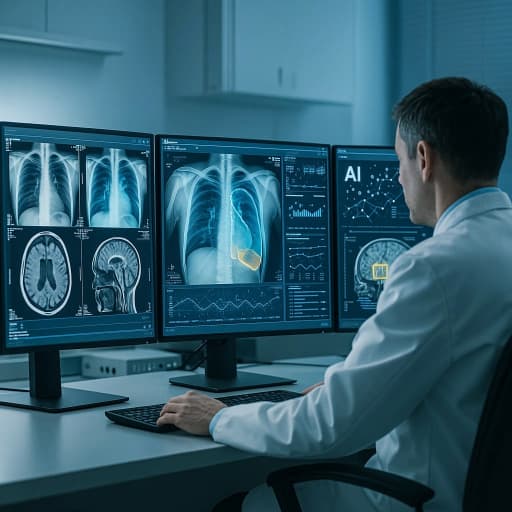AI is Revolutionizing Medical Imaging: Reducing Diagnostic Errors and Improving Patient Outcomes

Medical imaging is the cornerstone of modern healthcare, playing a vital role in diagnosing and treating countless medical conditions. From X-rays and MRIs to CT scans and ultrasounds, these technologies provide critical insights into the human body. However, traditional medical imaging processes are not without challenges. Diagnostic errors, time-consuming workflows, and the sheer volume of imaging data are hurdles that radiologists and healthcare professionals face daily.
Enter artificial intelligence (AI)—an innovation poised to transform medical imaging. By combining the power of machine learning algorithms with advanced data analysis, AI is revolutionizing the way we interpret medical images. The result? Faster, more accurate diagnostics, reduced errors, and ultimately, improved patient outcomes.
Let's explore how AI is reshaping the field of medical imaging and why it's becoming an essential tool for modern healthcare providers.
1. Enhancing Diagnostic Accuracy
One of the greatest challenges in medical imaging is achieving consistently accurate diagnoses. Human interpretation, while highly skilled, is not immune to fatigue, cognitive bias, or the limitations of human perception. This is where AI steps in as a powerful ally.
AI algorithms, trained on thousands of medical images, can detect subtle patterns and anomalies that might be overlooked by even the most experienced radiologists. For instance, in detecting early-stage cancers, AI systems excel at identifying minute changes in imaging data that are difficult to spot with the naked eye.
Moreover, AI systems are designed to support radiologists—not replace them. By acting as a second set of eyes, these tools provide an added layer of assurance, reducing the likelihood of misdiagnosis and increasing confidence in clinical decisions.
2. Speeding Up the Diagnostic Process
Time is of the essence in healthcare, particularly in critical cases where early diagnosis can mean the difference between life and death. Traditional imaging workflows often involve multiple steps, from image acquisition and analysis to reporting. This process can take hours—or even days—depending on the complexity of the case and the availability of specialists.
AI drastically shortens this timeline. Advanced algorithms can process and analyze imaging data in a matter of minutes, offering preliminary results that radiologists can review and validate. For example, AI can quickly highlight areas of concern in an MRI scan, allowing radiologists to focus their attention where it's needed most.
This efficiency doesn't just save time—it also improves patient outcomes. Faster diagnoses enable quicker treatment decisions, which is particularly crucial for conditions like stroke, where every second counts.
3. Reducing Radiologist Workload and Burnout
The sheer volume of medical imaging data has grown exponentially in recent years. Radiologists are often tasked with reviewing hundreds of images daily, leading to long hours and increased risk of burnout. Over time, this can affect the quality of care and lead to errors.
AI offers a solution by automating routine and repetitive tasks. For example:
- AI can pre-screen and prioritize cases based on urgency, ensuring that critical cases are addressed first.
- Algorithms can annotate and segment medical images, highlighting areas of concern and reducing the time radiologists spend on manual analysis.
By streamlining these processes, AI helps radiologists focus on complex cases that require their expertise, ensuring a better balance between workload and quality of care.
4. Improving Patient Outcomes
At the heart of AI's impact on medical imaging is its ability to improve patient outcomes. By reducing diagnostic errors, enabling early detection of diseases, and accelerating treatment decisions, AI contributes to more effective and personalized care.
For example, in oncology, AI-driven imaging tools can help identify tumors at earlier stages, leading to higher survival rates. Similarly, in cardiology, AI can detect abnormalities in heart imaging that might otherwise go unnoticed, enabling timely interventions for conditions like coronary artery disease.
Additionally, AI can assist in monitoring disease progression over time. By analyzing changes in medical images across multiple scans, these systems provide valuable insights that help clinicians adjust treatment plans and optimize patient care.
5. The Future of AI in Medical Imaging
The integration of AI into medical imaging is just the beginning. As technology continues to evolve, we can expect even more sophisticated applications, such as:
- AI-powered imaging platforms that integrate seamlessly into hospital workflows.
- Real-time image analysis during surgeries or procedures.
- Enhanced collaboration between AI systems and human experts, leading to even greater accuracy and efficiency.
While challenges like data privacy and regulatory approval remain, the potential of AI to transform medical imaging is undeniable. By reducing errors, improving efficiency, and ultimately saving lives, AI is proving to be an invaluable tool in the hands of healthcare professionals.
Conclusion
Artificial intelligence is not just a technological advancement—it's a paradigm shift for medical imaging. By enhancing diagnostic accuracy, accelerating workflows, and supporting radiologists in their work, AI is addressing some of the most pressing challenges in modern healthcare.
For healthcare professionals and radiologists, the adoption of AI is an opportunity to deliver better care while easing the burden of an increasingly demanding field. And for patients, it's a promise of faster, more accurate diagnoses and improved outcomes.
As AI continues to evolve, its role in medical imaging will only grow, paving the way for a future where technology and human expertise work hand in hand to revolutionize healthcare.
Ready to Experience AI-Powered Healthcare?
Join thousands of healthcare professionals and patients already using Sangya AI.
Get Started Free